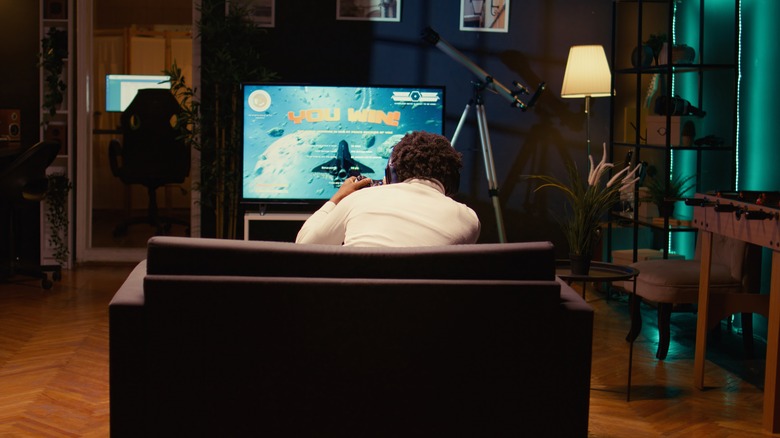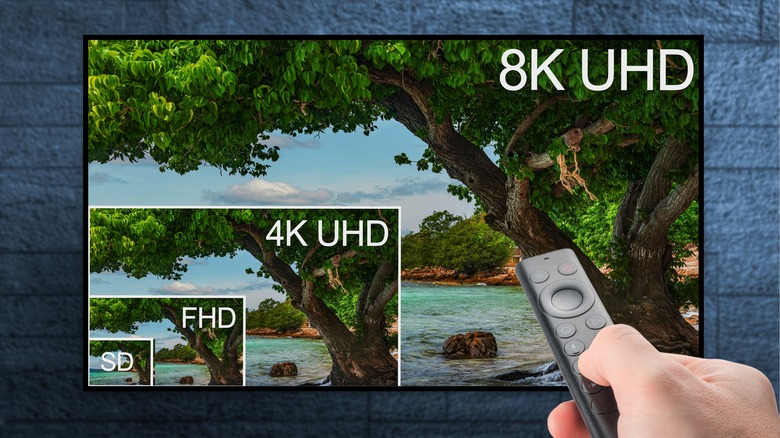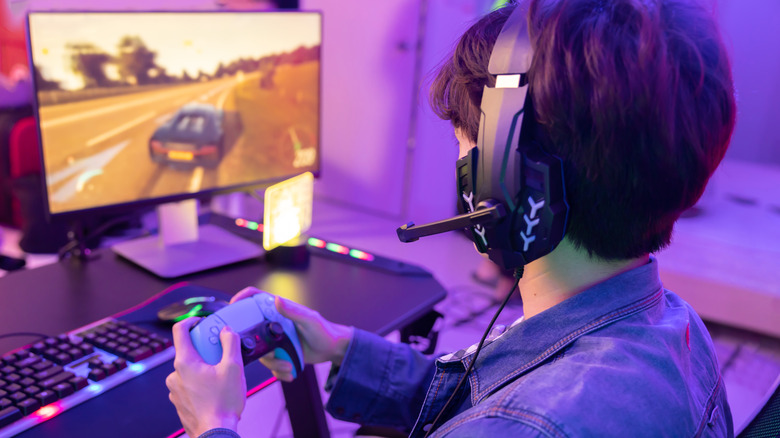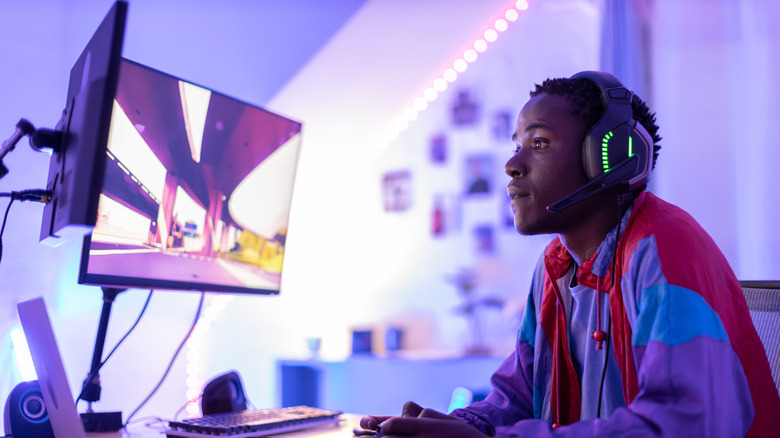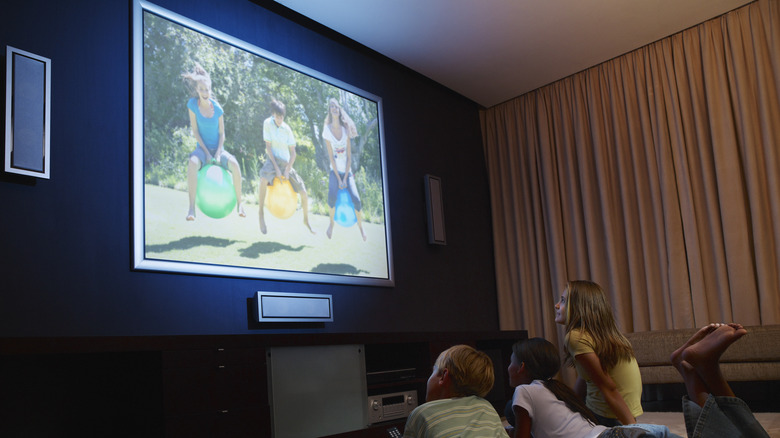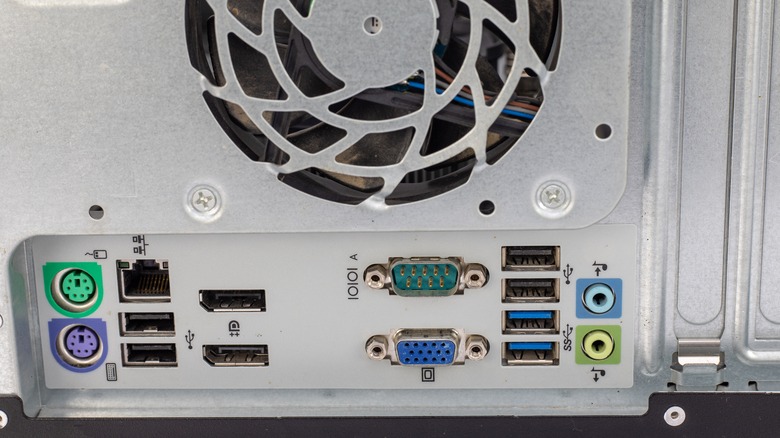TV Vs. Monitor: Which One Is Better For Gaming?
In the old days of the original Nintendo, if a gamer wanted to play on their console, they had to use the family TV. Millennials and Gen Xers remembers those large, blocky, CRT TVs that are oddly making a comeback. Granted, televisions today are significantly better for gaming than the '90s. In fact, it was impossible to connect a console to a computer monitor, so that thought never would have crossed anyone's mind. It's different for gamers now.
Gamers today freely swap between TVs and computer monitors, sometimes using both simultaneously. It usually comes down to preference and the type of games they play. Even those operating completely on a computer might choose to use a TV because either it's what their budget allows or they have some multiplayer games that allows for split screen play.
So, is there an objective answer to the question, "Are monitors or TVs better for gaming?" Looking at technical specs without considering price, not really. It falls under a matter of preference because looking at the best possible image in a video game doesn't necessarily translate to the overall best experience. Here's all the qualities of TVs and monitors for gaming.
Picture quality
The quality of a TV or computer monitor's picture is usually the first thing any person will notice when shopping around. It doesn't matter if you're a gamer or not, you want a good looking image on the screen. TVs and monitors process their images a little differently from each other, but TVs get the advantage here. TV manufacturers build processors into their TVs to improve picture quality, giving the image a more cinematic quality. That's what allows so many TVs offer "motion smoothing" as an option.
OLED or Mini-LED displays are standard for the bulk of TVs on the market, while gamers will have to pay a little extra for a monitor with that kind of technology. However, the pixel density on a monitor is better, giving the image a sharper look than on a TV. Ever look at a spreadsheet on a TV and notice it's a little blurry? That's because of there being fewer pixels per inch (PPI) compared to a monitor. Pixel density is big contributor to the screen's picture quality.
Monitors are smaller than most TVs and the larger the TV, the worst the PPI is. A 55-inch 4K TV has 80 PPI. Meanwhile, a 27-inch 4K monitor has 163 PPI. Even if that same monitor had a resolution of 1080p, it would have a PPI of 81.59, nearly identical to a 55-inch 4K television. Any video game played on that monitor will look twice as sharp as it would on a TV.
Refresh rate
The refresh rate of a display is easily one of the most important details to consider when looking for the best gaming experience. However, to understand a display's refresh rate, one has to also understand frames per second (fps) or frame rate. The refresh rate of a display is the speed at which the image on the screen updates within a second. This is measured in Hertz (Hz) and essentially tells you how many frames of the game players will see. The frame rate refers to the number of times the game renders the image on the screen within a second, but if the frame rate is higher than the refresh rate of the display, players aren't going to see every frame.
The higher the refresh rate the better because it's going to display smoother action on the screen. Plain and simple, computer monitors are superior to TVs in this department because they're capable of producing faster refresh rates. Unless paying for the absolute best, TVs typically only accommodate 60Hz. Some get as high as 120Hz but that's as good as it gets for TVs right now.
Computer monitors, on the other hand, can come with a refresh rate of anywhere between 60Hz and 240Hz. There are a some monitors that can even reach 500Hz. Monitors also come with variable refresh rate (VRR) technology that syncs up a game's fps with the screen's refresh rate to make the gameplay as smooth as possible. TVs didn't start implementing VRR until 2022.
Latency or input lag
Gamers want their physical actions to translate to their digital avatars in a game instantaneously. While there will always be a slight delay between pressing a button on the keyboard, mouse, or controller and the corresponding action happening on the screen, gaming monitors are designed to minimize that response time. TV manufacturers focus more on delivering a better cinematic experience for their customers. Gaming typically falls lower on the list of priorities. The input lag is significantly higher for TVs, taking anywhere between six and 20 milliseconds (ms) for a game to respond to the player's action. This is because of the built-in processors previously mentioned.
To minimize the latency, TVs have a "Game Mode" or "PC Mode," which disables the processor so the TV doesn't go through all those extra steps to improve the image. While this drops the quality of the picture it'll still look good enough for gaming. Netflix might not be as pretty, though, so anyone who cares about that should switch out of the game mode. Computer monitors, especially ones designed for gaming, will have a significantly lower response time, usually one millisecond or less.
Monitors don't have processors like TVs, so they have a direct connection to the peripherals. The only delay is from the amount of time it takes for the electronic signal to get from the controller, mouse, or keyboard to the monitor.
TV and monitor sizes
There are no computer monitors that can compete with TVs in the size department. Sure, there are some monitors that are exceptionally wide, curved even, but it's difficult to compete when there are 100-inch TVs. A giant TV is great when you're playing an old game that has split screen multiplayer like "Halo 3" or you're merely playing for fun. "Cyberpunk 2077" on a large television with great resolution is absolutely breathtaking. However, there are diminishing returns when the screen passes a certain threshold in size, especially when it comes to competitive gaming.
When playing something like "Valorant," "Counter-Strike," or "Apex Legends," seeing every angle and slight movement is imperative. Computer monitors have the best sizes for competitive gamers. They don't require players to sit too far back in order to see the entire screen and they won't have to sit so close that they won't be able to see movement at the edges. So, if you're playing competitive games, a computer monitor is ideal, but if you're playing casually and simply want to have a fun time with friends, then a TV isn't a terrible choice.
Connections
Connectivity is one of those features that really comes down to preference. TVs are great for anybody who wants to play on their older consoles, such as an N64 because TVs have RCA connections. To play old N64 games with a computer monitor, players would have to find an adaptor, learn emulation, or find their old games on PC storefront. However, if they value refresh rate over playing older consoles, then gamers are going to want to use a DisplayPort. A port that is significantly more rare on TVs.
HDMI tends to be the standard for TVs. Look at the side or back panel of any TV and there are multiple HDMI ports. But if a gamer wants to use DisplayPort, it's not going to be as hard to find a monitor with it. Why would somebody choose DisplayPort over HDMI? It offers a higher refresh rate than HDMI at the same resolutions. Lenovo says DisplayPort "transmits video and audio signals with less compression than any other connection type."
Of course, a monitor is only capable of reaching a specific refresh rate, so you're not going to get 800Hz on a monitor that tops out at 240Hz. Furthermore, monitors typically have more USB ports than TVs, giving gamers the ability to connect more peripherals and storage devices. When all is said and done, even if the technical specs support one device over another, it all comes down to preference.
